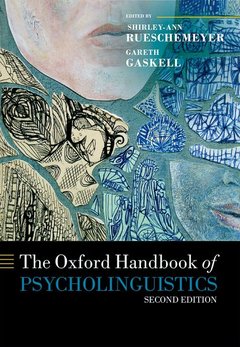Description
The Oxford Handbook of Psycholinguistics (2nd Ed.)
Oxford Library of Psychology Series
Coordinators: Rueschemeyer Shirley-Ann, Gaskell M. Gareth
Language: English
Subjects for The Oxford Handbook of Psycholinguistics:
The Oxford Handbook of Psycholinguistics
Publication date: 08-2018
1088 p. · 17.1x24.6 cm · Hardback
Publication date: 08-2018
1088 p. · 17.1x24.6 cm · Hardback
Oxford handbook of psycholinguistics (paperback) (series: oxford library of psychology)
Publication date: 01-2009
880 p. · 17.4x24.5 cm · Hardback
Publication date: 01-2009
880 p. · 17.4x24.5 cm · Hardback
Description
/li>Contents
/li>Biography
/li>
The ability to communicate quickly and flexibly through both spoken and written language is one of the defining characteristics of the human race. Yet it remains a mysterious process. The science of psycholinguistics attempts to uncover the mechanisms and representations underlying human language. This interdisciplinary field has seen massive developments over the last decades, with a broad expansion of the research base, and the incorporation of new experimental techniques such as brain imaging and computational modelling. The result is that real progress is being made in the understanding of the key components of language in the mind. This new and expanded edition of The Oxford Handbook of Psycholinguistics brings together the views of over 80 experts in various domains of psycholinguistic research, offering a comprehensive and authoritative review of the field. With contributions from the fields of psychology, linguistics, cognitive neuroscience, attention, genetics, development, and neuropsychology divided into five themed sections, this new edition of The Oxford Handbook of Psycholinguistics is unparalleled in its breadth of coverage. The comprehensive nature of this book coupled with the accessibility of the short chapter format makes this handbook essential reading for students and researchers in the fields of psychology, linguistics and neuroscience.
Part I - Word Recognition. 1. Representations and representational specficity in speech perception and spoken word recognition. 2. Audiovisual speech perception and word recogniton. 3. Eight questions about spoken word recognition. 4. Statistical and connnectionist models of speech perception and word recognition. 5. Visual word recognition. 6. Eye movements and visual word recogntion. 7. Speech and spelling interaction: the interdependence of visual and auditory word recognition. 8. Brain processes of word recognition as revealed by neurophysiological imaging. 9. Word recognition in aphasia. Part II - The Mental Lexicon. 10. Representation and processing of lexically ambiguous words. 11. Morphological processes in language comprehension. 12. Semantic representation. 13. Conceptual structure. 14. Connectionist models of reading. 15. The mulitlingual lexicon. 16. The biocognition of the mental lexicon. Part III - Comprehension and Discourse. 17. Syntactic parsing. 18. Spoken language comprehension: insights from eye movements. 19. Eye movements and on-line comprehension processes. 20. Inference processing in discourse comprehension. 21. Language and action: creating sensible combinations of ideas. 22. Bilingual sentence processing. 23. Event-related brain potential (ERP) studies of sentence processing. 24. Neuroimaging studies of sentence and discourse comprehension. 25. Sentence level deficits in aphasia. Part IV - Language Production. 26. Alignment in dialogue. 27. Grammatical encoding. 28. Word form retrieval in language production. 29. Speech production. 30. The problem of speech patterns in time. 31. Connectionist principles in theories of speech production. 32. Cross-linguistic research on language production. 33. Brain imaging studies of language production. 34. Language production in aphasia. Part V - Language Development. 35. The perceptual foundations of phonological development. 36. Statistical learning in infant language development. 37. Word learning. 38. Concept formation and language development: count nouns and object kinds. 39. Learning to parse and its implications for language acquisition. 40. Learning to read. 41. Developmental dyslexia. 42. Genetics of language disorders: clinical conditions, phenotypes and genes. Part VI - Perspectives. 43. The psycholinguistics of signed andspoken languages: how biology affects processing. 44. Spoken language processing by machine. 45. Relating structure and time in linguistics and psycholinguistics. 46. Working memory and language. 47. Language and mirror neurons. 48. The evolution of language: a comparative perspective. 49. Thinking across the boundaries: psycholinguistic perspectives.
Shirley-Ann Rueschemeyer is an Associate Professor in Psychology at the University of York, UK. She received her first degree from the University of Regensburg in Germany. She completed her PhD at the Max Planck Institute for Human Cognitive and Brain Sciences, Leipzig, Germany, and spent several years as a research fellow at the Donders Centre for Cognition in Nijmegen, NL. Her research has focused on understanding the role of the social world in language comprehension, the neural correlates of language comprehension, and bilingual language comprehension. M. Gareth Gaskell is a Professor of Psychology at the University of York, UK. He received his first degree from Cambridge University, UK and was awarded a PhD from Birkbeck College, University of London, UK. Professor Gaskell has strong interests in both psycholinguistics and memory, with a particular focus on the interface between the two. He has developed a model of spoken-word recognition, and has studied written and spoken language perception and production across a wide range of languages. More recently he has explored the involvement of sleep in the process of learning and consolidating linguistic knowledge in adults and children.
© 2024 LAVOISIER S.A.S.




